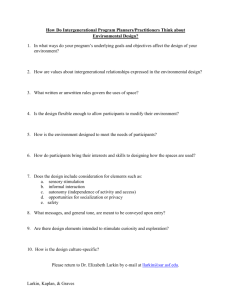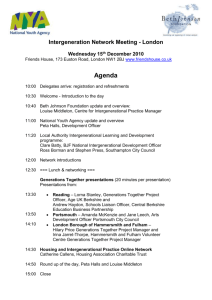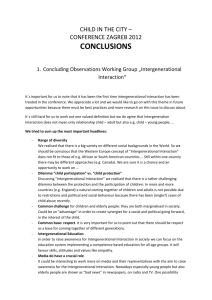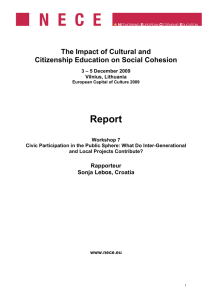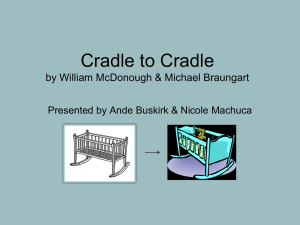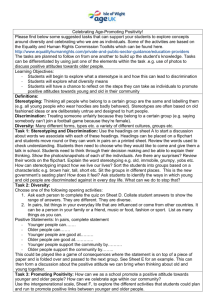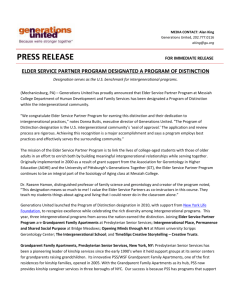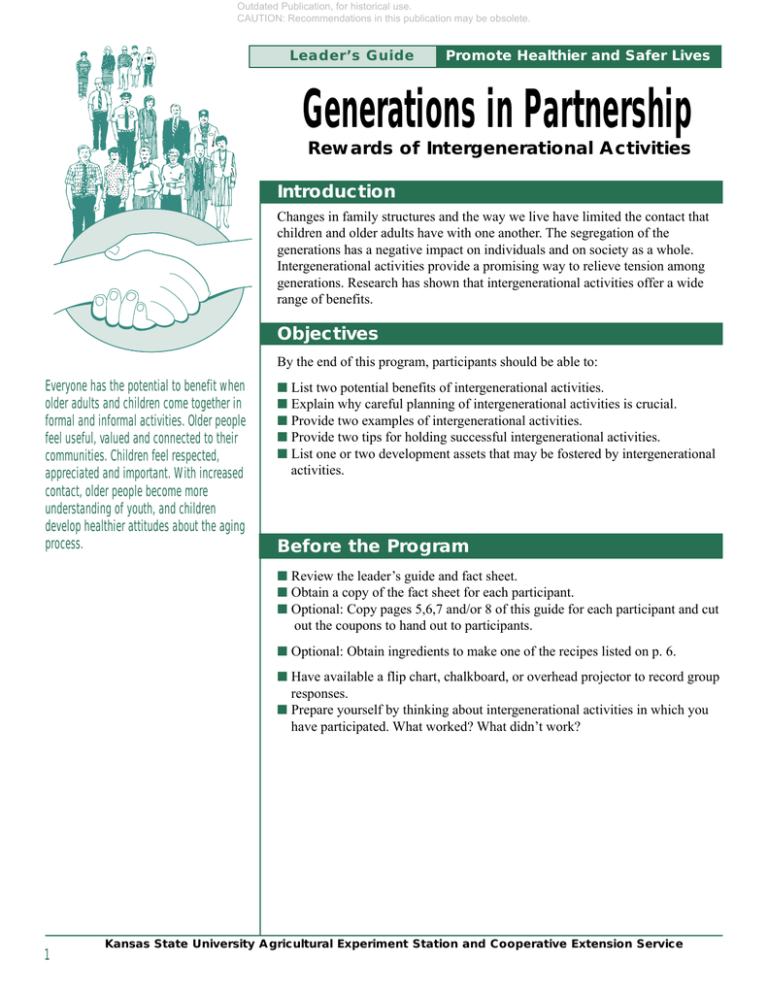
Outdated Publication, for historical use.
CAUTION: Recommendations in this publication may be obsolete.
Leader’s Guide
Promote Healthier and Safer Lives
Generations in Partnership
Rewards of Intergenerational Activities
Introduction
Changes in family structures and the way we live have limited the contact that
children and older adults have with one another. The segregation of the
generations has a negative impact on individuals and on society as a whole.
Intergenerational activities provide a promising way to relieve tension among
generations. Research has shown that intergenerational activities offer a wide
range of benefits.
Objectives
By the end of this program, participants should be able to:
Everyone has the potential to benefit when
older adults and children come together in
formal and informal activities. Older people
feel useful, valued and connected to their
communities. Children feel respected,
appreciated and important. With increased
contact, older people become more
understanding of youth, and children
develop healthier attitudes about the aging
process.
■ List two potential benefits of intergenerational activities.
■ Explain why careful planning of intergenerational activities is crucial.
■ Provide two examples of intergenerational activities.
■ Provide two tips for holding successful intergenerational activities.
■ List one or two development assets that may be fostered by intergenerational
activities.
Before the Program
■ Review the leader’s guide and fact sheet.
■ Obtain a copy of the fact sheet for each participant.
■ Optional: Copy pages 5,6,7 and/or 8 of this guide for each participant and cut
out the coupons to hand out to participants.
■ Optional: Obtain ingredients to make one of the recipes listed on p. 6.
■ Have available a flip chart, chalkboard, or overhead projector to record group
responses.
■ Prepare yourself by thinking about intergenerational activities in which you
have participated. What worked? What didn’t work?
1
Kansas State University Agricultural Experiment Station and Cooperative Extension Service
Outdated Publication, for historical use.
CAUTION: Recommendations in this publication may be obsolete.
Promote Healthier and Safer Lives
Generations in Partnership
•
Resources
The Importance of Intergenerational Activities
Kansas Intergenerational Network
132 South Main
Ottawa, KS 66067
(913)242-5466
www.ott.net/~kin/kinpage.htm
Describe why intergenerational activities are important. Discuss how our family
structure and the way we live often limits contacts between children and older
people. Mention that, as our population ages, developing intergenerational unity
is particularly important. For example, political conflicts over scarce resources
often pit young and old against each other, creating intergenerational tension.
Describe how generations may develop negative stereotypes of each other and
unhealthy attitudes about aging. Have participants:
Kansas Health Foundation
309 East Douglas
Wichita, KS 67202-3405
1-800-373-7681
www.kansashealth.org
Youth Friends
1000 Broadway, Suite 302
Kansas City, MO 64105
1-877-842-7082 (Toll free)
www.youthfriends.org
Generations Together
University Center for Social and Urban
Research
121 University Place, Suite 300
Pittsburgh, PA 15260
(412)648-7150
www.pitt.edu/~gti
Generations United
c/o Child Welfare League
440 First St., NW, Suite 480
Washington, D.C. 20001-2085
(202)662-4283
www.gu.org
Search Institute
700 S. Third St., Suite 210
Minneapolis, MN 55415
1-800-888-7828
www.search-institute.org
2
■ List some of the negative stereotypes that older people have of children.
■ List some of the negative stereotypes that children have of older people.
■ List attitudes that children often have about the aging process.
Record participants’ responses on the writing surface you have chosen to use
(flip chart, chalk board or blank transparency).
The Benefits of Intergenerational Activities
Discuss how intergenerational activities can be used to reduce the stereotypes
and negative attitudes that were just listed. Write down the following benefits
that have been derived from research. Ask participants to add to the list based on
their experiences. Intergenerational activities have the potential to:
■ Foster cooperation and sharing.
■ Improve social skills.
■ Build friendships and social networks.
■ Enhance self esteem and morale.
■ Reduce stereotypes.
■ Improve attitudes about, and knowledge of, the aging process.
Activity Examples
Discuss the following types of activities that have been used successfully with
older adults and children. Within each activity category, get participants to give
examples of specific activities they have done that were successful.
■ Teaching a game or skill to one another. Each group takes turns playing
mentor and student. Older people might teach an old-fashioned game, while
providing a history lesson in the process. Children might teach an activity
they excel at, such as using computers.
■ Sharing a meal and related activity, such as making ice cream or learning
about different meal customs.
■ Taking part in community service tasks, such as a neighborhood clean up.
Including time for refreshments or a short, fun activity makes this task more
enjoyable.
■ Participating in an arts and crafts project. The project should fit with individuals’ skill level and give everyone a chance to lead and follow.
■ Sharing favorite things, such as favorite memories, books, foods, games,
songs, family stories or jokes.
Outdated Publication, for historical use.
CAUTION: Recommendations in this publication may be obsolete.
Promote Healthier and Safer Lives
Volunteering Helps
Others
Describe how intergenerational activities
might be used as a way to address needs
of elders and youth. Describe how these
activities not only help the ones who are
receiving the services, but also provide
benefits to the volunteers. Make sure to
point out that in order for volunteer
programs to provide safe and successful
opportunities for youth and elders, they
should be run by experienced leaders. Get
participants to provide answers to the
following questions and record their
responses:
■ What volunteer tasks might youth do to
help older people?
■ What volunteer tasks might older
people do to help children?
■ What are some benefits that volunteers
receive from taking part in these
activities?
3
Generations in Partnership
Importance of Planning
Discuss the crucial role of planning in order to develop successful
intergenerational activities. Provide the following example from the research
literature. Children who visit nursing facilities without preparation often come
away with more negative attitudes toward older adults and the aging process
than those who don’t take part in such visits. Make sure to stress the fact that
simply getting the generations together is not sufficient to ensure a rewarding
event. In fact, it may do more harm than good. Careful planning, along with
Importance
of Planning
knowledge of the needs and abilities of the participants, is essential to the
success of intergenerational activities.
Tips for Success
Review the following tips for success. Get participants to add to the list based
on their experiences.
■ Make planning a participatory activity. Let participants help plan the event to
give them ownership of the outcome.
■ Provide advance education. Educate participants about each other in advance
Tips
for Success
of the activity. For example:
■ Tell older adults about the skills and behaviors to expect from the
children with whom they will be working.
■ Tell children that most older people live in homes just like their own.
Only about 4% of adults 65+ live in nursing homes. Stress that many
older people are healthy and independent.
■ Give everyone a role. Help insure that everyone gets involved in the activity
by giving them something meaningful to do.
■ Encourage interaction. Choose interactive, participatory activities. Activities
where everyone is moving around and “learning by doing” are much more
successful than lecture and discussion formats.
■ Let each group serve in the teaching role. If only one group plays the teaching
role, the other group may be forced to sit and listen during the entire activity.
Promote interaction by allowing both groups to play the roles of teacher and
student.
■ Make participation voluntary. Not all older adults want or need to be around
children. Pressuring them to participate will only backfire. Children may be
required to participate due to school or club rules. If so, involve them as much
as possible in the planning of the event so that they are eager and willing
participants.
Outdated Publication, for historical use.
CAUTION: Recommendations in this publication may be obsolete.
Selected Research
Articles
Aday, R.H., Rice, C., & Evans, E. (1991).
Intergenerational Partners Project: A Model
Linking Elementary Students with Senior
Center Volunteers. The Gerontologist, 31,
263-266.
Hirshorn, B.A. & Piering, P. (1998-99). Older
people at risk: Issues and Intergenerational
Responses. Generations, 22, 49-53.
Kaplan, M. (1993). Recruiting senior adult
volunteers for intergenerational programs:
Working to Create a “Jump on the Bandwagon” Effect. Journal of Applied Gerontology, 12, 71-82.
Keuhn, V.S. (1996). Evaluating your
Intergenerational Program: Four Recommendations for Human Service Practitioners. The Southwest Journal on Aging, 12,
27-32.
Newman, S., Faux, R., & Larimer, B. (1997).
Children’s Views on Aging: Their Attitudes
and Values. The Gerontologist, 37, 412-417.
Seefeldt, C. (1987). The Effects of
Preschoolers’ Visits to a Nursing Home. The
Gerontologist, 27, 228-232.
Short-DeGraff, M.A., & Diamond, K. (1996).
Intergenerational Program Effects on Social
Responses of Elderly Adult Day Care
Members. Educational Gerontology, 22,
467-482.
Developmental Assets
Intergenerational activities may provide good opportunities to foster
“developmental assets” in children. (Optional activity: Circulate copies of the
handout on the 40 Developmental Assets on p. 5 of this guide.) Point out that
the developmental assets are a list of 40 skills, experiences and beliefs that help
children to become productive, contributing members of our society. These
assets are considered by the Search Institute to be the building blocks of healthy
development. Read and discuss the following examples of assets that may be
addressed by intergenerational activities. (If participants have the handout, get
them to pick out assets that are likely to be fostered by intergenerational
activities and record their responses.)
■ Asset 7. Community Values Youth. The young person perceives that adults in
the community value youth.
■ Asset 8. Youth as Resources. The young person is given useful roles in the
community.
■ Asset 9. Service to Others. The young person serves the community one hour
or more per week
■ Asset 14. Adult Role Models. The young person sees parents & others model
positive, responsible behavior.
■ Asset 26. Caring. The young person places high value on helping others.
■ Asset 34. Cultural Competence. The young person has knowledge of, and
comfort with, people of different backgrounds.
Optional Activities
Pass out the sheet of fun recipes for intergenerational gatherings. Review the
recipes with participants and, if desired, prepare one of the recipes with
participants to have as a snack during the program.
Pass out the sheet of successful intergenerational activities. Briefly describe the
PATH project and make sure participants know how to contact the PATH office.
PATH stands for Personal Actions to Health. The PATH project is a K-State
Research and Extension project funded by the Kansas Health Foundation. The
current focus of the PATH project is to promote intergenerational activities
among older people and children throughout Kansas. You can contact the PATH
office at 1-800-681-7284. Review the three activities listed on this sheet. Ask
participants to share how they might implement these, or similar, activities.
Pass out copies of the coupons to participants. Point out that these coupons are
based on the developmental assets. Get participants to share how they might use
their coupons. Discuss other ways they might promote developmental assets in
their interactions with children.
Community Service Activities
Have participants turn to the “Helping Adults and Kids Build Relationships,”
(page 3 of fact sheet). Review together the list of suggestions under
“Encouraging Others to Build Intergenerational Relationships.” Have
participants talk about how they might implement one or more of these
suggestions.
4
Outdated Publication, for historical use.
CAUTION: Recommendations in this publication may be obsolete.
40 Developmental Assets
The Search Institute has identified the following building blocks of healthy development.
Search Institute, 700 S. Third Street, Suite 210, Minneapolis, MN 55415; 1-800-888-7828; www.search-institute.org
Asset Type
Support
External Assets
Asset Name and Definition
1. Family support. Family life provides high levels of love and support.
2. Positive family communication. Young person and her or his parent(s) communicate positively and young person is willing
to seek advice and counsel from parent(s).
3. Other adult relationships. Young person receives support from three or more non-parental adults.
4. Caring neighborhood. Young person experiences caring neighbors.
5. Caring school climate. School provides caring, encouraging environment.
6. Parent involvement in schooling. Parent(s) are actively involved in helping young person succeed in school.
Empowerment
7. Community values youth. Young person perceives that adults in the community value youth.
8. Youth are resources. Young people are given useful roles in the community.
9. Service to others. Young person serves in the community one hour or more per week.
10. Safety. Young person feels safe at home, school, and in the neighborhood.
Boundaries & Expectations
11. Family boundaries. Family has clear rules and consequences and monitors the young person’s whereabouts.
12. School boundaries. School provides clear rules and consequences.
13. Neighborhood boundaries. Neighbors take responsibility for monitoring young people’s behaviors.
14. Adult role models. Parent(s) and other adults model positive, responsible behavior.
15. Positive peer influences. Young person’s best friends model responsible behavior.
16. High expectations. Both parent(s) and teachers encourage the young person to do well.
Constructive Use of Time
17. Creative activities. Young person spends three or more hours per week in lessons or practice in music, theatre or other arts.
18. Youth programs. Young person spends three or more hours per week in sports, clubs or organizations at school and/or in
the community.
19. Religious community. Young person spends one or more hours per week in activities in a religious institution.
20. Time at home. Young person is out with friends “with nothing special to do” 2 or fewer nights/wk.
Asset Type
Commitment To Learning
Internal Assets
Asset Name and Definition
21. Achievement motivation. Young person is motivated to do well in school.
22. School engagement. Young person is actively engaged in learning.
23. Homework. Young person reports doing at least one hour of homework every school day.
24. Bonding to school. Young person cares about her or his school.
25. Reading for pleasure. Young person reads for pleasure three or more hours per week.
Positive Values
26. Caring. Young person places high value on helping other people
27. Equality and social justice. Young person places high value on promoting equality and reducing hunger and poverty.
28. Integrity. Young person acts on convictions and stands up for her beliefs.
29. Honesty. Young person “tells the truth even when it is not easy.”
30. Responsibility. Young person accepts and takes personal responsibility.
31. Restraint. Young person believes it’s important not to be sexually active or to use alcohol/drugs.
Social Competencies
32. Planning and decision- making. Young person knows how to plan ahead and make choices.
33. Interpersonal competence. Young person has empathy, sensitivity, and friendship skills.
34. Cultural competence. Young person has knowledge of and comfort with people of different cultural/racial/ethnic
backgrounds.
35. Resistance skills. Young person can resist negative peer pressure and dangerous situations.
36. Peaceful conflict resolution. Young person seeks to resolve conflict nonviolently.
Positive Identity
37. Personal power. Young person feels he or she has control over “things that happen to me.”
38. Self-esteem. Young person reports having a high self-esteem.
39. Sense of purpose. Young person reports that “my life has a purpose.”
40. Positive view of personal future. Young person is optimistic about her or his personal future.
5
Outdated Publication, for historical use.
CAUTION: Recommendations in this publication may be obsolete.
Useful Books
Friedman, B.M. (1999). Connecting
Generations: Integrating Aging and
Education and Intergenerational Programs
with Elementary and Middle Grades
Curricula. Boston, MA: Allyn & Bacon.
James, H.F. (1996). Across the Generations:
Selecting and Using Intergenerational
Resources. Fort Atkinson, WI: Highsmith.
Newman, S., Ward, C.R., Smith, T.B.,
Wilson, J.W. & McCrea, J.M. (Eds.). (1997).
Intergenerational Programs: Past, Present
and Future. Washington, D.C.: Taylor &
Francis.
Fun Recipes for Intergenerational Gatherings
Preparing food together can be fun, while also providing opportunities to teach
children about food preparation, nutrition, and even history.
Here are two fun recipes to use as intergenerational activities:
Apple Smiles
Ingredients
1 medium red apple, cored and sliced
Peanut butter
Miniature marshmallows
■ Spread one side of each apple slice
with peanut butter.
■ Place three or four miniature
marshmallows on top of the peanut
butter on one apple slice.
■ Top with another apple slice,
peanut butter side down. Squeeze
gently.
■ Eat right away. Makes 6 to 8.
Homemade
Ice Cream in a Bag
Ingredients
1 T. sugar
1/2 c. milk (no skim milk)
1/2 t. vanilla
6 T. salt
ice
1 quart zip-lock bag
1 gallon zip-lock bag
■ Mix sugar, milk and vanilla in a
quart zip-lock bag and seal bag
■ Place sealed quart bag into a gallon
zip-lock bag
■ Add 6 T. salt
■ Fill gallon bag half full of ice and
seal.
■ Shake bag 5 minutes or until
mixture has turned to ice cream
■ Wipe off salt from the outside of
the quart bag
■ Enjoy your ice cream right from the
bag
1 bag = 1 serving
Related Activity: One way to expand upon the ice cream activity is for an older
participant to bring an old-time crank ice cream maker and show the children
how it was used. This might lead to a general discussion of how food was
prepared before modern conveniences.
6
Outdated Publication, for historical use.
CAUTION: Recommendations in this publication may be obsolete.
Successful Intergenerational Activities
The PATH (Personal Actions To Health) Project is working with sites around the
state of Kansas to hold intergenerational activities for older adults and young
children. PATH is a project of K-State Research and Extension that is funded by
the Kansas Health Foundation. Two activities that PATH sites have found
particularly successful are teaching children about the games of another
generation, and holding intergenerational potlucks with special themes.
Descriptions of these two activities are included below, followed by an
explanation of “Listening Posts,” a program used successfully by other
organizations. To learn more about the PATH project, call 1-800-681-PATH.
Games of another generation
Teaching games to children that were popular when their grandparents and great
grandparents were children has been a well-received intergenerational activity at
PATH sites. In some cases, a group of older adults have made arrangements with
a local elementary school to meet with the children during recess to teach them
old-fashioned games. To give children leadership roles, opportunities are also
provided for the children to teach some of their favorite games to the older
adults. This activity is not limited to schools and could be done with a variety of
groups (e.g., scouts, 4-H, sports programs, etc.). A related activity is teaching
the children how to make simple toys that the older adults played with as
children. One example is to teach the children how to make simple stilts using
coffee cans and twine. Careful supervision is an important part of this activity!
Intergenerational Theme Potluck
PATH participants (both older adults and children) have greatly enjoyed
intergenerational theme potlucks. One successful theme is “School Days.” For
the School Days potluck, the older adults bring mementos from their school
days to display, including a school photograph. The children also bring things
from school to display. Seating is done carefully to ensure that there is
approximately the same number of adults and children at each table. Sheets of
questions are placed at each table to help open conversations between adultchild pairs. Questions might include: What was/is your favorite thing about
school? What is your favorite school memory? Who was/is your favorite teacher
and why? Who was/is your best friend from grade school? Tell something about
him/her. At some point during the potluck, the children are asked to work
together to guess the identities of the people in the photographs. After the
guesses are in, the older adults come forward to identify themselves and claim
their photos.
Listening Posts: Older adults providing a listening ear
Some communities around the country are providing school programs where
older adults join children at lunchtime. One such program is called the
“Listening Post” program. Adults are stationed at special places throughout the
lunchroom. The children know that they can sit and talk with the older adults
about anything that is on their minds. Schools using this program have seen a
meaningful reduction in discipline problems during the lunch hours when the
older adults are present.
7
Outdated Publication, for historical use.
CAUTION: Recommendations in this publication may be obsolete.
Promote Healthier and Safer Lives
Generations in Partnership
Making a difference for a child only takes an instant. Simple things like smiling or
remembering their name show children you care, Children who feel loved are more
likely to grow up healthy and secure. And that makes everyone a winner.
Children who feel valued have a better chance of growing up healthy and secure.
Something as simple as saying hello shows children they are worthwhile. It takes less
time than clipping a coupon. And its value can’t be discounted
Brand names appearing in this publication are for product identification purposes only. No endorsement is intended, nor is criticism implied of similar products not
mentioned.
Publications from Kansas State University are available on the World Wide Web at: http://www.oznet.ksu.edu. Contents of this publication may be freely reproduced for
educational purposes. All other rights reserved. In each case, credit Deborah Altus, Ph.D. and Angela Hayes, M.S., Generations in Partnership, Kansas State University,
October, 2000.
Kansas State University Agricultural Experiment Station and Cooperative Extension Service
MF-2469
October 2000
It is the policy of Kansas State University Agricultural Experiment Station and Cooperative Extension Service that all persons shall have equal opportunity and
access to its educational programs, services, activities, and materials without regard to race, color, religion, national origin, sex, age or disability. Kansas State
University is an equal opportunity organization. Issued in furtherance of Cooperative Extension Work, Acts of May 8 and June 30, 1914, as amended. Kansas State
University, County Extension Councils, Extension Districts, and United States Department of Agriculture Cooperating, Marc A. Johnson, Director.
8

